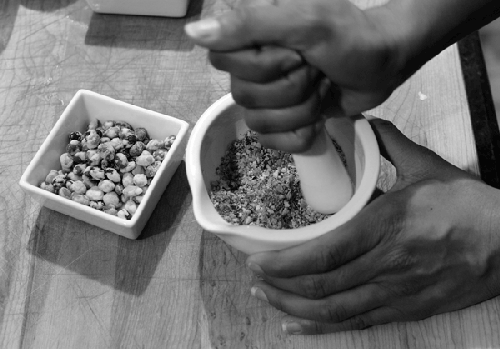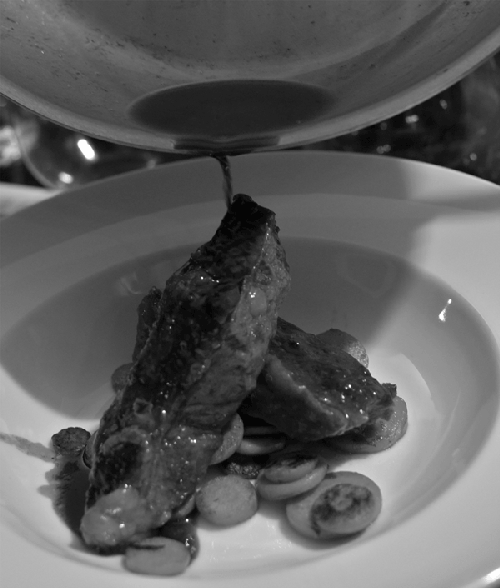Scallops are one of
those surprisingly easy but often-overlooked items. Sure, fresh scallops can be
expensive, but you only need a few for a quick appetizer or part of a
meal.
Prepare the scallops for cooking by patting them dry with a paper towel and placing
them on a plate or cutting board. If your scallops still have their bases attached, peel
them off using your fingers and save them for some other purpose.
Note:
Not sure what to do with those little side muscles attached to the main body of
the scallop (scallop bases)? Pan fry them after you cook the scallop bodies and nibble
on them when no one is looking.
Place a frying pan over medium-high heat. Once the pan is hot, melt about 15g / 1
tablespoon of butter—enough to create a thick coating—in the pan. Using a pair of tongs,
place the scallops, flat side down, into the butter. They should sizzle when they hit
the pan; if they don’t, turn the heat up.
Let them sear until the bottoms begin to turn golden brown, about two minutes. Don’t
poke or prod the scallops while they’re cooking; otherwise, you’ll interfere with the
heat transfer between the butter and scallop flesh. Once the first side is done cooking
(you can use the tongs to pick one up and inspect its cooked side), flip the scallops to
cook on the second flat side, again waiting until golden brown, about two minutes. When
you flip them, place the scallops on areas of the pan that didn’t have scallops on them
before. These areas will be hotter and have more butter; you can take advantage of this
to cook the scallops more readily.
Once cooked, transfer the scallops to a clean plate for serving.
Notes
Try serving these scallops on top of a small simple salad—say, some
arugula/rocket tossed with a light balsamic vinegar dressing and some diced
shallots and radishes.
If you’re not sure if the scallops are done, transfer one to a cutting
board and cut it in half. You can hide the fact that you checked for doneness by
slicing all of the pieces in half and serving them this way. This lets you check
that they’re all done as well.
You can dredge the uncooked scallops in bread-crumbs or another light,
starchy coating. If you have wasabi peas, use either a mortar and pestle or
blender to grind and transfer them to a plate for dredging the
scallops.
Try crushing wasabi-coated peas and dredging the scallops in them
before searing.

Sautéing vegetables will bring a
pleasant nutty, toasted flavor to dishes such as braised short ribs.
In a skillet, cook at medium heat until browned, about 5 minutes:

Carrots, sliced into thin rounds or wedges no thicker
than around ¼″/ 0.5 cm
Olive oil or butter to coat pan
generously
Notes
Don’t overcrowd the pan. You need the outside of the carrots to get
hot enough for the sugars to caramelize. If you put too many in the pan, they’ll
end up steaming.
The olive oil or butter helps transfer heat. The oil creates a thin
layer between the carrot and the pan surface, convecting heat between the two
within that very thin layer.
You’ll probably want to add a pinch of salt as well. Try grinding on a
hefty dose of black pepper. Glazed carrots are made by cooking them with sugar
(try adding a tablespoon of brown sugar and a tablespoon of water), or by
finishing the carrots with maple syrup. Fresh sage or other aromatic herbs can be
julienned and tossed in at the end as well.
Skillet-Fried Potatoes
Frying potatoes in a heavy cast iron pan develops rich flavors from the starches
breaking down and caramelizing. Try serving these potatoes with the butterflied chicken
or as part of breakfast accompanied by eggs and bacon.
In a medium-sized pot, bring salted water to a boil and cook for 5 minutes:
3–4 medium (700g) potatoes, diced into “forkable”
bite-sized pieces
Drain the potatoes and transfer to a heavy cast iron or enamel pan on a burner set
to medium heat. Add:
2–4 tablespoons (25–50g) olive oil or other fat
(leftover chicken, duck, or bacon fat tastes great)
1 teaspoon (6g) kosher salt
Stir every few minutes, flipping the potatoes so that the face-down sides have
enough time to brown but not burn. Once most of the potatoes are browned on most sides,
about 20 minutes, turn the heat down to low, add more oil or fat if necessary, and
add:
2 teaspoons (4g) paprika
2 teaspoons (2g) dried oregano
1 teaspoon (2g) turmeric powder
Notes
This recipe uses two types of heat: first, boiling, to raise the
temperature of the entire potato to quickly cook the starches, and then sautéing,
to raise the temperature of the outside. (No, par-cooking isn’t just about making
even more dirty dishes. The par-cooking step speeds up cooking time because the
water imparts heat into the potatoes faster. You can skip the par-cooking step and
just cook the potatoes in the pan, but they will take an extra 30 minutes or so to
cook.)
If you’re cooking this as part of a breakfast or brunch, try adding
diced red bell peppers, yellow onions, and small chunks of
bacon.